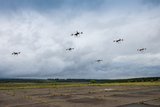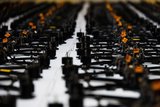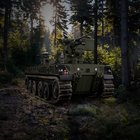US Navy foresees an uncrewed future for its surface and underwater fleet
The service has been conducting various procurement and development efforts to integrate unmanned surface and underwater vehicles into its inventory.
Following a successful series of trials, QinetiQ is now working alongside key government partners to deliver a robot based service that is being used to help fight fires and support other major incidents - particularly if acetylene gas cylinders are involved which can become highly unstable - thereby protecting fire fighters plus helping minimise disruption to travellers by reducing resulting delays on major transport systems in and around London.
This initiative is funded jointly by Network Rail, the Highways Agency and Transport for London, in collaboration with the London Fire Brigade. The two year contract currently covers incidents within Greater London and surrounding counties but national coverage is possible with additional funding and extended call out times.
If acetylene gas cylinders are thought to be involved in a fire, the London Fire Brigade and others can request QinetiQ attend and deploy a range of remotely operated vehicles (ROVs) with all-terrain capabilities.
These can then enter environments that could be potentially unsafe for fire fighters. Their cameras can identify whether any acetylene cylinders are present and, using thermal imaging, can gauge whether the cylinders are sufficiently cool for the Brigade to safely approach and remove them. The ROVs can also be used to gain access to premises and vehicles, target cooling onto cylinders, move debris and other items, or assess other potential risks.
Standard Fire & Rescue Service procedure is to impose an initial hazard zone of 200m for up to 24 hours if acetylene gas cylinders are present and have been involved in fire - which causes enormous disruption to transportation routes and local communities who have to be evacuated.
This is because the risk of explosion following heating can remain long after the fire is extinguished and even after extensive cooling has been applied. Recent experience during the operational trials have shown that when QinetiQ's robots are used at incidents, hazard zone restrictions can, on some occasions be reduced in as little as two hours from the time that they are in attendance.
"When fires break out near the railway they are often in circumstances where there is a suspicion that acetylene gas cylinders may be involved," explained Simon Christoforato, QinetiQ's business group manager for robotic systems.
"In recent years there have been an increasing number of rail line-side fires and acetylene incidents across London, each causing massive disruption to passengers. During the 2008 trials QinetiQ responded to a total of 17 incidents and helped reduce the average period for the hazard zone to be in place from over 19 hours to less than three and has so far responded to more than 10 incidents under this contract in 2009."
Assistant Commissioner for Operational Policy at London Fire Brigade, Jon Webb says the QinetiQ trial had played a key role in the Brigade's successful efforts to reduce the impact of acetylene cylinder fires in the capital.
"The successful trial of the ROVs, the improved provision of technical advice on the incident ground, together with a process of raising awareness and reinforcing understanding of the operational procedures to be applied at cylinder incidents have all been integral to the overall reduction in the average time that hazard zones are in place.
In London we have also seen a reduction in the number of acetylene cylinder incidents overall thanks to our on-going campaign with local authorities to ensure the safe use, signage and storage of acetylene cylinders and to create a greater awareness of the dangers they bring when they are involved in a fire."
Robin Gisby, Network Rail's Director of Operations and Customer Service added the use of ROVs was good news for train users: "Anything we can do to reduce travel delays for passengers is high on our list of priorities but so is overall safety. The deployment of the ROVs will give us more options for faster resolution of incidents and hopefully lead to less disruption to train services."
The Highways Agency is also carrying out a study that could see QinetiQ's remotely operated vehicles modified for easier vehicle entry and potential use at a number of roadside incidents.
"All our efforts are designed to ensure that travellers are informed and can reliably make journeys on safe roads," stated Mark Clark, responsible for Incident Management at The Highways Agency. "Roads are regularly affected by major incidents so anything we can do to deal with the problems and reduce delays for commuters is a good thing. We are working with QinetiQ to develop the robotic solution to meet our national needs going forward."
"Hazard zones are necessary to deal with fires and other major incidents and can have a major knock-on effect on the road, bus and tube network causing disruption for motorists and our passengers," concluded Richard Stephenson, Transport for London Director of Group Health, Safety and Environment. "Trials suggest this new equipment could have a real impact on cutting the length of time hazard zones are in place, while maintaining the safety of the emergency services and the travelling public."
QinetiQ's remotely operated vehicles are extensively used in Iraq and Afghanistan to combat improvised explosive devices and deal with roadside bombs but they are also ideal for a range of other dirty and dangerous tasks including dealing with hazardous materials and Chemical, Biological, Radiological and Nuclear (CRBN) incidents.

The service has been conducting various procurement and development efforts to integrate unmanned surface and underwater vehicles into its inventory.

Tekever has manufactured the AR3, AR4 and AR5 UAS with all systems sharing common electronics and software architecture, which has enabled the reuse of ground segment elements within the new ARX UAS.

As the dynamics of aerial combat rapidly evolve, Chinese scientists have engineered a sophisticated air separation drone model that can fragment into up to six drones, each capable of executing distinct battlefield roles and challenging the efficacy of current anti-drone defences such as the UK’s Dragonfire laser system.

Advancements in air defence technologies have begun to reshape aerial combat dynamics in the Middle East, as illustrated by recent events involving the Israeli Air Force and Hezbollah.

Both sides of the Russia-Ukraine war have been using UAS for effective low-cost attacks, as well as impactful web and social media footage. Thousands more have now been committed to Ukrainian forces.

The US Army has intentions to develop light, medium and heavy variants of the Robotic Combat Vehicle (RCV) as part of the branche’s Next Generation Combat Vehicle family.